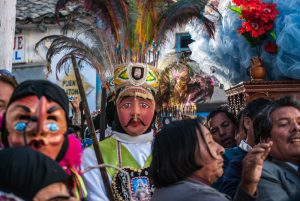
Art in Cuzco is not pure. It is a fusion of our ancestral traditions that go back to the Inca culture and before as well as to the customs and folklore of Spain. Cuzco is more. It is a great cosmopolitan city and has its own great riches of folklore and culture.
Cuzco is one of the most dynamic cities of Peru and, as it modernizes, it does so based on the current forms of its traditions. Its Quechua roots have a constant impact, in all its manifestations. This makes the city unique, authentic, and attractive in the eyes of tourists.

The art of Cuzco is very rich, in all its expressions. But dance and music, from ancient times have become an important part of the life of its population. It is a form of expressing joy, manifested in religious celebrations, feasts of patron saints, in families, for carnival, etc.
All of them maintain a relationship with a religious matrix. In Cuzco, we can say that there is no celebration in which you will not find dances. Both music and dance come together. Without doubt dance is the highest of our arts. It is both something people manifest instinctively and which carries constant development and refinement.

Cuzco is a whole universe of dances. Many of them are also performed in other parts o Peru. In the rural zones of Cuzco we have a great variety of dances that manifest our Andean essence. The multicolor costumes are an important distinction. Some are more Andean than others as a result of the mixture of Pre-Hispanic elements with European clothing that the indigenous peoples were required to wear during the colonial epoch.

In many cases only men perform the dances, such as in the case of war dances. In others, such as agricultural dances, men and women perform together. This all depends on the kinds of dance carried out.

Some of the dances that are performed today have a continuity with centuries of dance. They have been constantly renewed in time. These include the chunchus, ukukus, and the kachampa. Others arose in colonial times as an expression of Mestizo art, taking sometimes ironically European elements. These include collas, majeño, negritos, zambitos, doctorcitos, etc. Other dances are satirical. They parody playful devils, the sijllas, and the poor administration of justice.
Cuzco celebrates hundreds of festivals each year. The majority of them is in homage to a Holy patron and forms part of the Christian calendar that was adopted in colonial times. Nevertheless, they have mixed with magical beliefs and ancient forms of religious cult. Among these we can mention the celebrations of Holy Week, Carnival, Corpus Christi, and the feast of the Lord of Temblors, among others. All of hem have special meaning for the people of Cuzco and are a rich expression of the folklore of its people.
Our Andean roots and our history are rich in tradition and culture. Dance and music are a symbol of Cuzco. Through them we value our culture and ourselves. We like to share it and along the way we mobilize our values and identify ourselves with the art of the Andean world.




